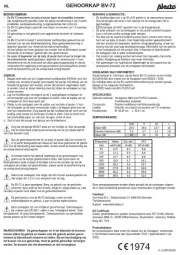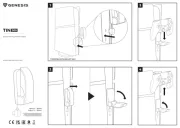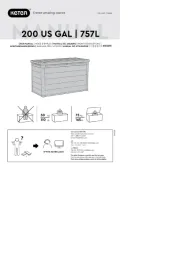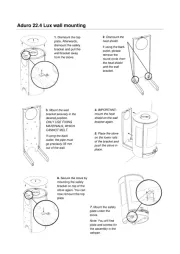Boss SDE-3000D Bedienungsanleitung
Boss
Nicht kategorisiert
SDE-3000D
Lies die bedienungsanleitung für Boss SDE-3000D (41 Seiten) kostenlos online; sie gehört zur Kategorie Nicht kategorisiert. Dieses Handbuch wurde von 14 Personen als hilfreich bewertet und erhielt im Schnitt 4.8 Sterne aus 7.5 Bewertungen. Hast du eine Frage zu Boss SDE-3000D oder möchtest du andere Nutzer dieses Produkts befragen? Stelle eine Frage
Seite 1/41

Reference Manual
© 2023 Roland Corporation
01

2
Connecting the Equipment
* To prevent malfunction and equipment failure, always turn
down the volume, and turn o all the units before making any
connections.
CTL 4, 5 jacks only (for the GA-FC)
INPUT
CTL 2, 3
EXP 1
OUTPUT ROUTPUT L
CTL 4, 5
EXP 2
GA-FC
There are many other ways to connect the SDE-3000D.
For details, refer to “Connecting an Amp and Conguring the Input/
Output Settings” (p. 9).
Turning the Power On
* Before turning the unit on/o, always be sure to turn the volume
down. Even with the volume turned down, you might hear some
sound when switching the unit on/o. However, this is normal and
does not indicate a malfunction.
1. Connect the AC adaptor to the DC IN jack.
This turns the power of the SDE-3000D on.
DC IN
AC adaptor
2. Turn on any connected devices rst, and then turn on
your guitar amp.
* Do this in reverse order when turning o the power.
* Unsaved data is lost when the power turns o. You must save any
data in advance that you want to keep.
* The bank and memory number that you were using when you
turned the power o are stored in memory, and are recalled when
you turn the unit back on.
Getting Ready
Attaching the Rubber Feet
You can attach the rubber feet (included) if necessary.
Attach them in the locations shown
* Using the unit without rubber feet may damage the oor.
* When turning the unit over, be careful so as to protect the buttons and knobs from damage. Also, handle the unit carefully; do not drop it.

3
Top Panel
1
5
6 2
3
Area Explanation
1
Controls
Press the top part of each button to increase the value, and
press the bottom part of each button to decrease the value.
Long-press a button to make its value change rapidly.
[TIME] buttons
Adjusts the delay time.
[FEEDBACK] buttons
Adjusts the delay feedback level.
[OUT] buttons
Adjusts the output level for the delay sound.
[RATE] buttons
Adjusts the cycle of the delay modulation.
[DEPTH] buttons
Adjusts the depth of the delay modulation.
A setting of zero turns the modulation o.
2
Memory
[1]–[4] buttons
Selects the memories.
Ø“Selecting a Memory” (p. 15)
[ ] [ ] buttonsã â
Switches the play screen in the following order: Input
level Parameter Õ Õ Tempo Õ Bank/memory
3
Bank
[BANK A] [BANK B] buttons
Switches between banks A and B.
You can select the bank C memories (C.01 and up) by
using your feet (p. 6).
Area Explanation
4
Delay settings
[FILTER] button
A delay lter. This gives you a natural-sounding eect
when you’re using the delay as an echo.
[TIME×2] button
Switches between delay time ranges.
O (×1): 0.0-1500 ms
On (×2): 0.0-3000 ms
[DELAY PHASE] button
Inverts the phase of the delay sound.
[MOD] button
Turns the modulation on/o.
[FEEDBACK PHASE] button
Inverts the phase of the delay sound’s feedback.
[DIGITAL DELAY 1] button (DDL 1) /
[DIGITAL DELAY 2] button (DDL 2)
Switches between the DDL 1 and DDL 2 parameter
displays.
When TIME LINK is OFF or OFFSET, you can switch
between time displays for the L channel (lights up
green) and the R channel (lights up ) of DDL 1/DDL 2.red
[SETUP] button
Congures the memory and system settings. Long-
press the button to turn the lock on/o. Other button
operations are disabled when the lock feature is
enabled.
5
Switches
[DDL 1] switch / [DDL 2] switch
Switches the DIGITAL DELAY 1/2 on and o.
[TAP/CTL 1] switch
Press this switch in specic intervals to set the delay
time. Also, use this for the CTL function and assign
setting functions.
You can select memories by pressing the [DDL 1] switch and
[DDL 2] switch at the same time, or by pressing the [DDL 2]
switch and [TAP/CTL 1] switch at the same time.
Ø“Selecting Memories via Foot Control” (p. 6)
6
Display
This shows various information depending on the operation.
Play screen
Ø“Switching Between Play Screen Displays” (p. 4)
Edit screen
ØSee the edit pages for details.
Panel Descriptions
Produktspezifikationen
| Marke: | Boss |
| Kategorie: | Nicht kategorisiert |
| Modell: | SDE-3000D |
| Display-Typ: | LED |
| Breite: | 199 mm |
| Tiefe: | 135 mm |
| Gewicht: | 1100 g |
| AC-Netzadapter: | Ja |
| Produktfarbe: | Schwarz |
| Übertragungstechnik: | Kabelgebunden |
| Höhe: | 54 mm |
| Energiequelle: | Gleichstrom |
| Eingebautes Display: | Ja |
| Anzahl USB 2.0 Anschlüsse: | 1 |
| Gleichstrom-Anschluss (DC): | Ja |
| Display-Hintergrundbeleuchtung: | Ja |
| 6,35 mm (1/4-Zoll) Eingang: | 2 |
| Einfach zum Lesen-Bildschirm: | Ja |
| MIDI-Out: | Ja |
| Bit-Rate: | 32 Bit |
| MIDI-In: | Ja |
| Geräuschkulisse: | Akustische Resonanz |
| 6,35 mm (1/4-Zoll) Ausgang: | 2 |
| Abtastraten: | -48 - 48 kHz |
| Anzahl Soundeffekte: | 100 |
Brauchst du Hilfe?
Wenn Sie Hilfe mit Boss SDE-3000D benötigen, stellen Sie unten eine Frage und andere Benutzer werden Ihnen antworten
Bedienungsanleitung Nicht kategorisiert Boss

4 September 2024

3 September 2024

3 September 2024

31 August 2024

31 August 2024

28 August 2024

26 August 2024

26 August 2024

26 August 2024

26 August 2024
Bedienungsanleitung Nicht kategorisiert
- Thermor
- Arista
- Elektrobock
- OK
- Pro User
- DNT
- SPL
- Neets
- Wacker Neuson
- Hamax
- Ridem
- Lorex
- DJI
- Royal Sovereign
- Core SWX
Neueste Bedienungsanleitung für -Kategorien-

17 Juni 2025

17 Juni 2025

17 Juni 2025

17 Juni 2025

17 Juni 2025

17 Juni 2025

17 Juni 2025

17 Juni 2025

17 Juni 2025

17 Juni 2025